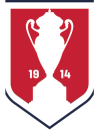Celtic punched their ticket to the Final with a 6-1 win over Niagara Rangers at Paterson’s Olympic Field, with Irish-born center forward Roddy O’Halloran netting a hat-trick.
Coats Field’s first Open Cup Final was greeted with all the appropriate pomp and pageantry. Newspapers compared the coming spectacle to the World Series, which at the time was the biggest sporting event in the country. The Dewar Trophy, the original Open Cup prize donated by Scottish distilling magnate Sir Thomas Dewar, was on display at the Wright & Ditson sporting goods store in Providence before being shown around town in Pawtucket.
Admission for the 3:30pm ET contest was set at 25 cents. According to local press reports, 6,000 were in attendance, however the following year’s Spalding Soccer Guide, compiled by U.S.S.F.A. secretary and Spalding employee Thomas Cahill, listed the crowd at 10,000.
Full House for the First
Whatever the official number, both the grandstand and bleachers were filled to overflowing, with spectators standing “seven and eight deep” according to The Evening Times of Pawtucket. Some even climbed atop the baseball scoreboard in left field of the multi-use facility for a bird’s-eye view (the photo in the X link below, though grainy, gives an idea).
Not surprisingly, the two clubs were bitter rivals. They played an exhibition game at Brooklyn’s Edison Field in March, with Celtic winning 2-0 -- one of the three exhibition losses suffered by the Field Club. So deep was the rivalry that when Celtic Manager Tom McCamphill learned both teams were booked on the same boat to Providence, he changed his team’s plans to travel by rail.
After scoring two goals in the Semifinal in the Field Club’s 2-1 win over New Bedford, Millar was again the star of the Final, although he didn’t get on the score sheet.
Just a few minutes into the contest, Millar sent a ball through to Adamson, who sent it spinning into the net for a 1-0 Field Club lead. Twenty-five minutes later, Neil Clarke pulled down O’Halloran and right wing Tom Campion tied the game via a penalty kick.
Windy conditions made attacking difficult, but with time running short, Millar had two attempts stopped by Celtic goalkeeper Frank Mather. After collecting the rebound from the second attempt, Millar backheeled the ball to Ford, who put it in the net for the winner.
The Cup medal was the first of four for the legendary Millar, who also won with Bethlehem Steel in 1915 and 1919 and with the New York Nationals in 1928. He later managed the United States National Team to a third-place finish at the 1930 World Cup in Uruguay and was a member of the first National Soccer Hall of Fame class in 1950.
The Challenge Cup/Open Cup Final shifted to Taylor Field in Bethlehem in 1915 but then returned to Coats Field for three straight years (1916, 1917 and 1918).
Cup Return to Rhode Island
After capturing their first title on home turf, Bethlehem Steel won their second straight Open Cup in 1916, defeating the Fall River Rovers 1-0 at Coats Field – although New England fans and supporters came to believe the result was stolen from the Massachusetts side.
With about ten minutes remaining in the game, Rovers left back Charley Burns and Steel forward Neil Clarke went up for a header. The two came down with Clarke landing on Burns. Referee David M. Whyte whistled a foul against Burns and awarded a penalty kick to Bethlehem, much to the protest of the Fall River club, as well as most of the 10,000 fans at Coats Field.
Tommy Fleming converted the penalty to give Bethlehem the advantage.
As Whyte was about to blow his whistle to end the game, a fan ran onto the field and attacked him. A mob then surrounded the ref, who was kicked, beaten and badly bruised before being rescued by a police officer with a drawn revolver.
Fall River exacted revenge a year later at the same site, beating Bethlehem Steel 1-0. This time, there was no controversy to speak of as the Fall River men took the lead on a goal by Tommie Swords barely a minute into the game and then managed to stave off a furious attack for 89 minutes.
In 1918, for the third straight year, the Rovers and Steelmen faced one another on familiar turf, that same field on Lansdowne Street in Pawtucket.










